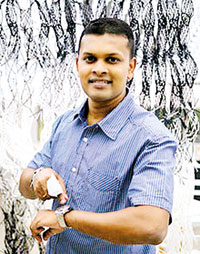CreateLab – Creating futures

Suranga Nanayakkara
Our kids learn in a system of education set up for a world that ‘progressively more and more’ does not exist.
Yes it’s hard to imagine, but it’s true. It was worse earlier, but now too to become a doctor, a lawyer, an engineer, etc has always been a matter of great esteem. Analysing general facts that more or less describe our societies and ourselves – we go by from kindergarten through to 12th grade school to university and professional schools, ending our education at some fixed stage to become a doctor, the engineer, a lawyer, etc and will be for a long time.
We “study and after this we execute”. After we finish school we go to work.
Kids are growing up in a very different world than their parents and the lines of the present day jobs are blurring fast because cellphones, computers, Youtube, Netflix, and Facebook are embedded in their daily lives.
Even toys are digital, and many are programmable, such as Legos and the new-generation LeapFrogs.
It’s a tech age now and anything that you need is online.
Computer programming is perceived as an important ability for the development of problem solving skills in addition to logical reasoning. Our dependence on technology will only increase. The students of today must be able to not only passively consume this technology, but also to understand and control it, becoming an active part of this huge digital shift, Suranga Nanayakkara, a founder of CreateLab, Singapore says.
As an Assistant Professor from the Engineering Product Development Pillar at Singapore University of Technology and Design (SUTD), he should know, because he is best known for his work EyeRing – a finger-worn interface for seamless interaction, Haptic Chair – audio visual system to provide a more satisfying musical experience to deaf people and StickEars – a sound-based sticky note like device to make everyday objects more accessible. Among some of his other work, Prof. Nanayakkara has invented SPARSH – a way to copy-paste data between digital devices and FingerDraw – a way to extract colours and textures from nature and bring them into digital drawings.
Prof. Nanayakkara is among that rare breed of engineers that has a sense of “humanity” in technology which ranges from practical behavioral issues, understanding real-life contexts in which technologies function, and understanding where technologies can be not just exciting or novel, but have a meaningful impact on the way people live. The connection he feels to the communities in which he lives and with whom he works is a quality that will ensure his research will always have real relevance and this is a primary factor for him to be so excited to be in the academic faculty at CreateLab, which tries to inspire children to become creators with technology and prepare them to become 21st Century Leaders.
“Their popular coding, robotics and design workshops have been recognised by parents as amongst the leading Coding and Computational Thinking enrichment programmes in Singapore,” Prof. Nanayakkara says.
It is one thing to know how to use these technologies but it’s another, however, to comprehend the logic behind them. When learning to programme, kids understand and tinker with the digital world they inhabit. Coding draws back the seeming “magic” of technology so they can truly understand the logic and science that controls this technology – a discovery that is all the more magical, he adds.
Prof. Nanayakkara says it’s crucial to inspire kids about the creative potential for computer science to transform society. “CreateLab guides kids to imagine, design, prototype, and build innovative software programmes in a fun and collaborative environment. Here they gain the hands-on skills they need to become technology creators and problem-solvers,” he says noting that they also learn the fundamental concepts and big ideas of computing.
Programming hasn’t become this popular by accident. There is a growing understanding that knowing how to programme is essential, especially for younger generations. Learning facts is less and less relevant in a world where Google can satisfy just about any question in a matter of milliseconds; it is skills that will enable children to succeed, and that set of skills must include programming.
CreateLab has stepped into fill this gap through curriculum focuses on instruction with group and independent practice activities that build creativity, communication, and collaboration, he says noting that CreateLab is now preparing the next generation to succeed in life.
That’s a tall order and it will substantially fail if it doesn’t teach children how to think critically and solve problems and prepare students for life, regardless of the profession they choose to follow. “The subjects teach students how to think critically and how to solve problems – skills that can be used throughout life to help them get through tough times and take advantage of opportunities whenever they appear.”


